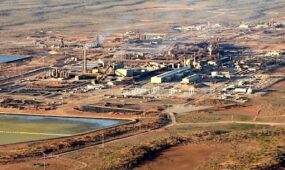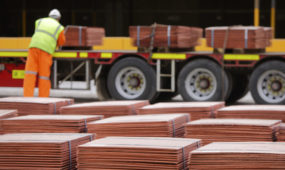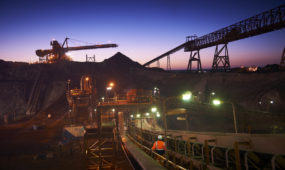Silicon energy storage technology scales up for commercial production
Mining & Resources
ONE of the most abundant elements on earth is being used to create an energy storage system that can heat homes as well as store electricity.

Sign up to receive notifications about new stories in this category.
Thank you for subscribing to story notifications.
South Australian company 1414 Degrees has developed technology to store electricity as thermal energy by heating and melting containers full of silicon at a cost estimated to be up to 10 times cheaper than lithium batteries.
Silicon is the second most abundant element in the earth’s crust after oxygen.
A tonne of silicon can store enough energy to power 28 houses for a day.
Its high latent heat capacity and high melting temperature of 1414 C – make it ideal for the storage of large amounts of energy.
The process also generates large amounts of clean useable heat, which can easily be utilised for district heating or industrial purposes.
1414 Degrees has created a full prototype ready for commercialisation in Adelaide, South Australia, of its patented thermal energy storage system (TESS).
The company completed its first trials in September with a small prototype test system using about 300kg of silicon to store about 150kw of energy.
It is now scaling up its technology to grid scale thermal energy storage systems with potential to dramatically improve the efficiency of wind and solar farms and will launch the first commercial machines this year.
1414 Degrees Chairman Dr Kevin Moriarty said the company was waiting for AusIndustry, a division of the Federal Department of Industry, Innovation and Science, to sign-off on the 10MWh project in February so manufacture could begin.
He said the company has two target markets: a device capable of storing 10MWh of energy a targeted at industry while the second 200MWh device was suitable for a wind farm, large solar array or gas-fired power station.
As well as its ability to stabilise South Australia’s electricity supply, which relies heavily on wind power, the system is likely to appeal to northern European countries because of its ability to store the wind energy of a cold Scandinavian night while keeping residents warm and running their computers the next day.
“It’s low cost for very large energy storage,” Dr Moriarty said.
“We’re not really competing with batteries, we’re going to be working in the space of district heating, major industry, electricity producers and suburb scale residential developments.
“The big problem with renewables is this need to shift the peak – we’ve got wind turbines roaring away at 3am in South Australia when nobody needs the power.
“That problem is huge in Europe as well – you need to match the demand to the generation and that’s not going to be met by lithium, it’s too expensive and you just need vast quantities to handle it.”
The TESS device stores electricity as thermal energy by heating and melting containers full of silicon at a cost estimated to be up to 10 times cheaper than lithium batteries. The high latent heat capacity and melting temperature of silicon – 1414 C – make it ideal for the storage of large amounts of energy.
1414 Degrees has calculated that it can install sufficient storage, capable of supplying hundreds of MW of electricity, at just $70,000 per MWh to provide for a reliable electricity supply with up to 90 per cent renewable sources.
Dr Moriarty said a site had been chosen in South Australia for the first 10MWh system. He said the systems also produced a lot of useable, clean heat, making them ideal for industry, district heating in the northern hemisphere and food processors.
“The idea will be to position these things near industry or get industry to move near to the very big units because it will be able to offer very clean, cheap heat.
“We don’t have any dirty emissions like you do from gas or coal so basically the heat comes out as hot air and can be used for all sorts of things.
“Also, you can keep using the silicon, it’s pretty much unlimited.”
The company, previously known as Latent Heat Storage, has been developing the technology for the past decade in partnership with Adelaide-based engineering consultancy ammjohn, and the University of Adelaide.
It aims to initially assemble the units at the Tonsley Innovation Hub in Adelaide and have its first 10MWh system operating by mid-year.
“Then we want to demonstrate the impact of one of our bigger units at a grid level so the search is on right now for a suitable site – preferably a wind farm,” Dr Moriarty said.
“We’ll pay for it because this will be the commercial test point for the large installation – we think we can build a 200MWh unit for (AU)$5-7 million.
“The plan is that we will then scale it up with further modules to something like 2-3 gigawatts of energy because that would enable you to store several days output and feed it back to the grid as required.
Dr Moriarty said the company had been fielding enquiries about the new technology almost daily.
“People are searching us out and coming to us worldwide and saying can you put one on our solar installation or, in the case of Denmark, to provide district heating,” he said.
“If we can demonstrate we can do that and do it cheaply then it’s going to change a lot of the economics and the reliability.”
“We want to move on it as fast as possible.”
South Australia leads the nation in the uptake of wind energy and roof-top solar with renewable sources accounting for more than 40 per cent of the electricity generated in the state.
However, the intermittent nature of renewable energy has been the cause of intense debate in Australia in recent months.
“I think we’re in the ideal place in South Australia because there’s a demonstrable need here,” Dr Moriarty said.
“We have a huge amount of renewable energy being wasted because they can’t match wind generation with the need.
“If we can demonstrate we can do that and do it cheaply then it’s going to change a lot of the economics and the reliability.”
Australian CleanTech Managing Director John O’Brien said energy storage would undoubtedly be a very significant part of the energy system as nations moved towards low or zero carbon targets in the next decade or two.
He said the relatively cheap price of silicon and its ability to be used over and over would help keep the overall lifecycle price down.
“The main alternative at the moment is large-scale lithium batteries – there’s plenty of lithium around as well and there’s some very large companies with massive factories producing lithium batteries,” O’Brien said.
“But if they can scale up what they are doing with silicon then that certainly has potential.
“Clearly the sun doesn’t shine at night and the wind doesn’t blow all of the time so we have to think a bit more carefully about how we manage it.”
Jump to next article



